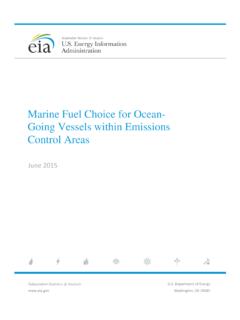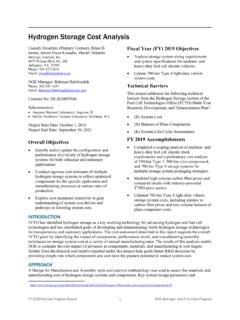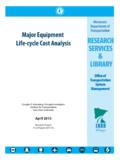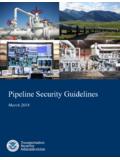Transcription of Energy Sector Market Analysis - NREL
1 A national laboratory of the Department of EnergyOffice of Energy Efficiency & Renewable EnergyNational Renewable Energy Laboratory Innovation for Our Energy Future Energy Sector Market Analysis Sponsored by the Weatherization and Intergovernmental Program (WIP) at DOE D. Arent, R. Benioff, G. Mosey, L. Bird, J. Brown, E. Brown, L. Vimmerstedt, J. Aabakken, and K. Parks National Renewable Energy Laboratory M. Lapsa, S. Davis, M. Olszewski, D. Cox, K. McElhaney, and S. Hadley Oak Ridge National Laboratory D. Hostick, A. Nicholls, S. McDonald, and B. Holloman Pacific Northwest National Laboratory Technical Report nrel /TP-620-40541 October 2006 nrel is operated by Midwest Research Institute Battelle Contract No. DE-AC36-99-GO10337 Energy Sector Market Analysis Sponsored by the Weatherization and Intergovernmental Program (WIP) at DOE D. Arent, R. Benioff, G. Mosey, L. Bird, J. Brown, E. Brown, L. Vimmerstedt, J. Aabakken, and K. Parks National Renewable Energy Laboratory M.
2 Lapsa, S. Davis, M. Olszewski, D. Cox, K. McElhaney, and S. Hadley Oak Ridge National Laboratory D. Hostick, A. Nicholls, S. McDonald, and B. Holloman Pacific Northwest National Laboratory Prepared under Task No. Technical Report nrel /TP-620-40541 October 2006 National Renewable Energy Laboratory1617 Cole Boulevard, Golden, Colorado 80401-3393 303-275-3000 Operated for the Department of Energy Office of Energy Efficiency and Renewable Energy by Midwest Research Institute Battelle Contract No. DE-AC36-99-GO10337 NOTICE This report was prepared as an account of work sponsored by an agency of the United States government. Neither the United States government nor any agency thereof, nor any of their employees, makes any warranty, express or implied, or assumes any legal liability or responsibility for the accuracy, completeness, or usefulness of any information, apparatus, product, or process disclosed, or represents that its use would not infringe privately owned rights.
3 Reference herein to any specific commercial product, process, or service by trade name, trademark, manufacturer, or otherwise does not necessarily constitute or imply its endorsement, recommendation, or favoring by the United States government or any agency thereof. The views and opinions of authors expressed herein do not necessarily state or reflect those of the United States government or any agency thereof. Available electronically at for a processing fee to Department of Energy and its contractors, in paper, from: Department of Energy Office of Scientific and Technical Information Box 62 Oak Ridge, TN 37831-0062 phone: fax: email: for sale to the public, in paper, from: Department of Commerce National Technical Information Service 5285 Port Royal Road Springfield, VA 22161 phone: fax: email: online ordering: on paper containing at least 50% wastepaper, including 20% postconsumer waste TABLE OF CONTENTS Executive Summary.
4 1 Cross- Sector Analytical Approach ..2 Buildings Sector Analysis ..3 Approach and Methodology ..3 Sector Buildings Sector Appendix ..10 Clean- Energy Sector Analysis ..17 Approach and Methodology ..17 Sector Industrial Sector Analysis ..29 Approach and Methodology ..29 Sector transportation Sector Analysis ..36 Approach and Methodology ..36 Sector iii 1 EXECUTIVE SUMMARY This paper presents the results of Energy Market Analysis sponsored by the Department of Energy s (DOE) Weatherization and Intergovernmental Program (WIP) within the Office of Energy Efficiency and Renewable Energy (EERE). The Analysis was conducted by a team of DOE laboratory experts from the National Renewable Energy Laboratory ( nrel ), Oak Ridge National Laboratory (ORNL), and Pacific Northwest National Laboratory (PNNL), with additional input from Lawrence Berkeley National Laboratory (LBNL).
5 The Analysis was structured to identify those markets and niches where government can create the biggest impact by informing management decisions in the private and public sectors. The Analysis identifies those markets and niches where opportunities exist for increasing Energy efficiency and renewable Energy use. DOE s Weatherization and Intergovernmental Program provides tools, information, and technical and financial assistance to help inform decisions by states, communities, tribal authorities, businesses, manufacturers, consumers, and international partners on the use of Energy efficiency and renewable Energy technologies and policies. This Analysis took a fresh look at key decisions that are driving the use of renewable Energy and Energy efficiency in buildings, electricity, industrial, and transportation markets. For these markets, the Analysis identified opportunities to increase the use of renewable Energy and Energy efficiency technologies and practices.
6 The Analysis attempted to answer the following questions: What are the current markets that WIP programs are addressing and what impacts is WIP having on these markets? What are the markets and segments within each Market that hold the most potential for increased RE and EE deployment? What are the major barriers for each of the markets and segments? Who are the key customers and decision makers in each Market and Market segment, and what needs do they have for information or assistance. Who are the other key actors in each Market and Market segment, what activities are they pursuing, and what opportunities exist for government to leverage resources and capabilities with these players? A common structure and format for the sectoral analyses was developed and performed for each of the target sectors: buildings, clean Energy , industry, and transportation . Data were compiled and developed from existing information sources, including: Total Energy use in the Sector Energy use by major groups of Energy users Current levels of technology penetration and Energy -savings technical potential Market drivers and barriers Key Market actors and stakeholders Investments in the Sector Methodologies, assumptions, and detailed results for each Sector are presented in the body of this report.
7 CROSS- Sector ANALYTICAL APPROACH Analysis Team The analytic team included: Cross- Sector Analysis : Douglas J. Arent, nrel Ron Benioff, nrel Buildings: Donna Hostick, PNNL Andrew Nicholls, PNNL Sean McDonald, PNNL Brad Hollomon, PNNL John Brown, nrel transportation : Gail Mosey, nrel Elizabeth Brown, nrel Laura Vimmerstedt, nrel J rn Aabakken, nrel Melissa Lapsa, ORNL Stacy Davis, ORNL Clean Energy : Lori Bird, nrel Elizabeth Brown, nrel Keith Parks, nrel Stan Hadley, ORNL Melissa Lapsa, ORNL Industrial: Mitch Olszewski, ORNL Karen McElhaney, ORNL Daryl Cox, ORNL 2 Buildings Sector Analysis Approach and Methodology The buildings Sector Analysis was prepared using readily available sources, including Energy Information Administration (EIA) and other Department of Energy (DOE) data, Weatherization and Intergovernmental Program (WIP) project Web sites, and other reports prepared on Energy efficiency and the buildings industry. More detailed information is contained in an appendix to this Analysis .
8 Sector Characteristics Baseline Market Assessment Building-related Energy use was almost quadrillion Btu1 (QBtu) in 2002, or approximately 40% of the total primary Energy use in the United States. Of that, approximately 52% is consumed by the residential Sector ;2 43% by the commercial Sector ;3 and 5% by the industrial sector4 for non-process-related Energy use associated with building Energy services ( , lighting, HVAC). Of the total, almost 50% is due to electricity-related Figure 1 illustrates the current and projected primary Energy consumption for the residential and commercial sectors. 010203040506020022005201020202025 Energy Consumption, QBtuCommercialResidential Figure 1. Buildings Sector Primary Energy Consumption6 In 2003, there were more than 112 million households and 70 billion square feet of commercial floor space. Each year, more than 1 million new housing units and 2 billion 1 Buildings Energy Data Book (BED), August 2004, Table , Table 2 BED, Table 3 BED, Table 4 BED, Table 5 BED, Table 6 BED, Tables and 3square feet of commercial floor space are Of the new housing units built, approximately 10% built in 2004 qualified for Energy Star,8 and approximately 26,700 homes have been built to date by participating Building America research Additionally, almost 2,000 commercial and institutional buildings (representing about 400 million square feet) have qualified for the Energy Star label.
9 This is equivalent to about of all commercial buildings and of commercial square Within the residential Sector , the greatest Energy uses among equipment are gas furnaces, incandescent lights, central air conditioning, refrigeration, and electric and gas water Refrigerator Energy efficiency, measured in kWh/unit/year, has greatly improved during the past 15 Gas furnace sales are now 30%-plus in the 90%- Annual Fuel Utilization Efficiency (AFUE)-and-over condensing range, with DOE/EPA Energy Star actively labeling these condensing units as Energy Star. Absent heat-pump breakthroughs, gas heating technology is at its physical-efficiency limit, as units nearing 100% efficiency are commercially By contrast, the efficiency picture for incandescent lights, and electric and gas water heating use, offers less evidence of success to date. Incandescent lights use more than 2 QBtu and have a low luminous efficacy about 75% lower than fluorescent lighting, for example.
10 Lighting offers large opportunities for efficiency gains, both because replacing incandescents with fluorescents saves a lot of Energy , and also because the first cost differential continues to fall. Water heaters, which use roughly the same amount of Energy , by contrast, do not offer consumers much in the way of efficiency/technology choice, and consequently there are no current Energy Star labels for water heating. Within the commercial Sector , the largest equipment Energy users are fluorescent and incandescent lighting, rooftop and unitary air-conditioning, nonpersonal computer (PC) office equipment, supply/return fans, and packaged EIA anticipates only moderate growth in Energy consumption for space heating, space cooling, and lighting due to current and proposed appliance However, as lighting consumes more than QBtu of Energy , it represents a great area of opportunity with the introduction of Super T-8s ; lighting controls; compact fluorescents (CFLs); and, in the future, light-emitting diodes (LEDs).
















